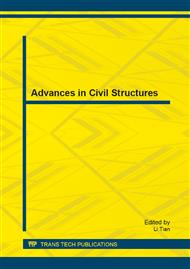p.1130
p.1138
p.1142
p.1146
p.1152
p.1159
p.1163
p.1168
p.1173
Deformation Monitoring and Evaluating Technology for Subgrade of Unballasted Track on Lan-Xin Passenger Dedicated Line
Abstract:
Lanzhou-Xinjiang passenger dedicated line is the first high speed railway on chinas northwestern Gobi where the temperature range is large and the wind is huge. Most road section of Lan-Xin passenger dedicated line is subgrade. This paper researches the ballastless track subgrade settlement observation scheme and assessment method on area where climatic conditions is harsh and geologic conditions is complex. The result shows that: the observation accuracy of subgrade settlement tests satisfies the requirement by using Layered settlement instrument, intelligent static force level and high-accuracy Hydraulic settlement instrument; Subgrade lies upon bedrock or Gobi soil with great bearing capacity in gale area, and distance between observation sections could be increased seemly. The space between observation sections generally should be less than 100m in areas where bedrock exposed, thick gravel soil distribute commonly; the distance between observation sections should be less than 50m in pre-mountain Alluvial-pluvial plain areas; hyperbolic method adapt the estimate of subgrade settlement on Gobi area, and the correlation coefficient is 0.97; Subgrade settlement deformation curve converges quickly and the settlement value after 40 days reaches 85% of ultimate settlement.
Info:
Periodical:
Pages:
1152-1158
Citation:
Online since:
August 2013
Authors:
Price:
Сopyright:
© 2013 Trans Tech Publications Ltd. All Rights Reserved
Share:
Citation:


